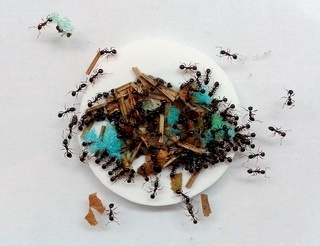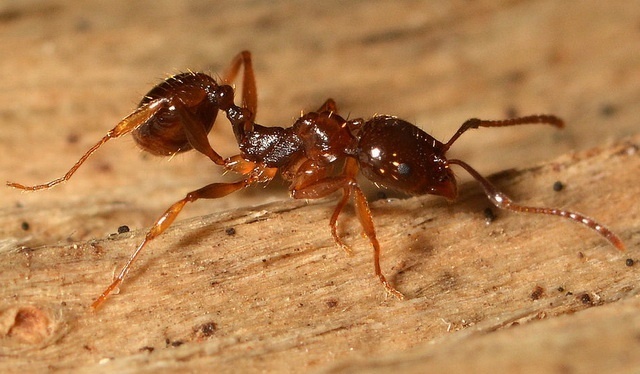Ants select best carrier material for collecting fluid food
The ant Aphaenogaster subterranea uses absorbent material to carry fluid food back to its nest. It selects the most easily portable material, or it takes material that is discovered first, as Gábor Lörinczi and colleagues observed.
Ants of many species possess a greatly distensible crop and a highly modified proventriculus, in which they transport large volumes of liquid food back home for their nest mates. But other species, among which Aphaenogaster subterranea, don’t possess such internal carrier sac. Still, they are able to collect fluid food. They drop debris in such food source, and grasp the food-soaked material with their mandibles to take it with them. Their choice of carrier material is flexible, Gábor Lörinczi and colleagues write.
Aphaenogaster subterranea occurs in forests in Central and Southern Europe. It lives in colonies, mostly in a nest in the soil, under a stone. Specialised workers collect fluid food for the colony: fruit pulp and body fluids of dead arthropods.
 Lörinczi held a number of nests in plastic boxes the laboratory and conducted experiments in which the nests were connected to a foraging arena via a plastic tube. In the foraging arena, he offered a drop of honey diluted in water or honey enriched with sugars as a liquid food source on a plastic disc; or he offered pure water as a control. Around the disc, he placed different piles of carrier material: small soil grains (1 millimetre in diameter), large soil grains (2 millimetre in diameter), pieces of pine needles (5 millimetre in length), pieces of plant leaves (5 millimetre in length) and pieces of sponge (5 millimetre in length). He then observed the foraging behaviour of the ants.
Lörinczi held a number of nests in plastic boxes the laboratory and conducted experiments in which the nests were connected to a foraging arena via a plastic tube. In the foraging arena, he offered a drop of honey diluted in water or honey enriched with sugars as a liquid food source on a plastic disc; or he offered pure water as a control. Around the disc, he placed different piles of carrier material: small soil grains (1 millimetre in diameter), large soil grains (2 millimetre in diameter), pieces of pine needles (5 millimetre in length), pieces of plant leaves (5 millimetre in length) and pieces of sponge (5 millimetre in length). He then observed the foraging behaviour of the ants.
Flexible
If all piles of ‘carrier bags’ were close to the food bait (at a distance of 4 centimetres), the ants selected mainly small soil grains to transport to and drop into the food. These grains are most easily transportable. If all piles were at greater distance (12 centimetres), the ants were less selective. And if one type of material was close to the food bait while the other types were not, they used that material relatively more often. So, the choice of carrier material is not fixed. The ants prefer small soil grains, but if something else is discovered sooner or more readily accessible, they will use that, maximizing their efficiency.
Leave fragments were used only infrequently, even if it could be found close to the food bait. This material is difficult to handle.
Ants that retrieved food-soaked material from the food bait, mainly picked up small soil grains. From honey, they also collected many pieces of sponge. As the authors suggest, these may be easy to pick up because of their buoyancy. They also observed that after a while, the ants started to tear the pieces of sponge into smaller fragments before using them.
Into water, objects were dropped infrequently, and no objects were retrieved from it.
So, workers of Aphaenogaster subterranea show flexibility in foraging tool use, and they even modify some material, which is unique among insects as far as is known.
Willy van Strien
Photos:
Large: Aphaenogaster subterranea. Christophe Quintin (via Flickr, cropped; Creative Commons CC BY-NC 2.0)
Small: The ants covered a drop of food with absorbent material. ©Gábor Lörinczi
Sources:
Lőrinczi, G., G. Módra, O. Juhász & I. Maák, 2018. Which tools to use? Choice optimization in the tool-using ant, Aphaenogaster subterranea. Behavioral Ecology, online August 1. Doi: 10.1093/beheco/ary110
Maák, I., G. Lőrinczi, P. Le Quinquis, G. Módra, D. Bovet, J. Call & P. d’Ettore, 2017. Tool selection during foraging in two species of funnel ants. Animal Behaviour 123: 207-216. Doi: 10.1016/j.anbehav.2016.11.005
